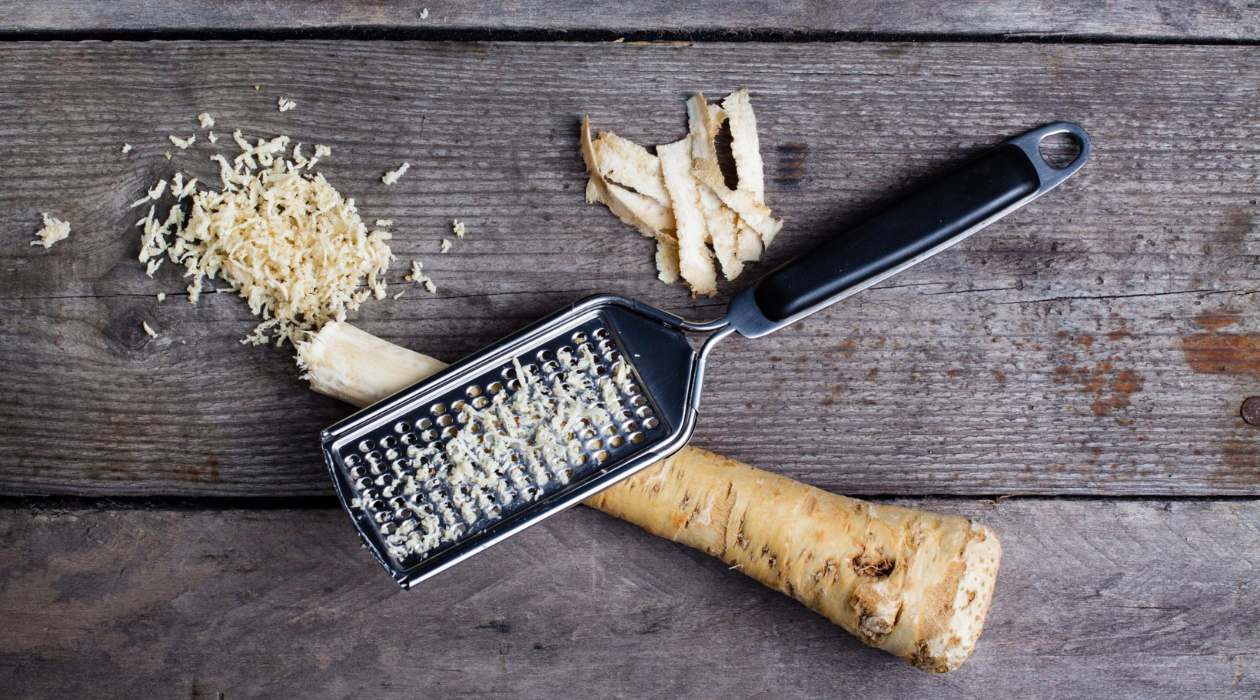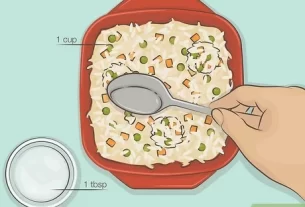If you’re a fan of bold and fiery flavors, chances are you’ve encountered the tangy heat of horseradish.
But have you ever wondered if this spicy root can go bad?
Well, buckle up as we dive into the world of horseradish storage and discover how to keep its zesty kick alive for longer!
In this article, we’ll unravel the mysteries surrounding the shelf life of horseradish, whether it’s the root itself, prepared horseradish, or the beloved horseradish sauce.
So, get ready to spice up your knowledge and savor the flavor, because it’s time to explore: Does horseradish go bad?
does horseradish go bad
Yes, horseradish can go bad.
Fresh horseradish root can last 1-2 weeks in the pantry and 1-2 months in the fridge.
Horseradish sauce usually has a best-by date on the label and can remain of good quality for a few months past that date.
Signs of spoilage include mold, discolorations, odd smell, or taste.
If the root has mold, feels soft and mushy, smells off, or has large black spots, it should be discarded.
Clean cutlery should be used when scooping horseradish sauce to minimize microbial contamination.
Key Points:
- Horseradish can go bad.
- Fresh horseradish root can last 1-2 weeks in the pantry and 1-2 months in the fridge.
- Horseradish sauce can remain of good quality for a few months past its best-by date.
- Signs of spoilage include mold, discolorations, odd smell, or taste.
- Mold, softness, off smell, or large black spots indicate that the root should be discarded.
- Clean cutlery should be used when scooping horseradish sauce to minimize contamination.
does horseradish go bad – Watch Video


Pro Tips:
1. Horseradish, a pungent root vegetable commonly used as a condiment, can remain fresh for an astonishingly long time. When stored correctly in a cool, dark place, uncut horseradish roots can stay good for up to 3 months.
2. Horseradish has been used for centuries not only as a condiment but also for its medicinal properties. It was traditionally believed to help relieve respiratory issues, boost immunity, and even assist in digestion.
3. The pungent flavor of horseradish comes from a compound called sinigrin, which is released when the root is grated or crushed. Sinigrin is part of a natural defense mechanism that protects the plant from pests.
4. Horseradish has a fiery reputation, and its heat comes from a natural process called enzymatic oxidation. When the roots are grated and exposed to air, an enzyme called myrosinase reacts with sinigrin, creating allyl isothiocyanate, which gives horseradish its intense spiciness.
5. Horseradish isn’t just limited to the white variety that is commonly found in stores. There are actually different varieties of horseradish, including red and purple. These variations offer slightly different flavors and appearances while still providing the signature kick.
Storing Horseradish Root: Fridge Or Room Temperature?
Horseradish root is a pungent and flavorful ingredient that can be stored in two different ways depending on your preferences and usage timeline. If you plan to use the horseradish root within a few days, it can be stored at room temperature without any issues. However, for a longer shelf life, it is best to store it in the refrigerator.
To store horseradish root in the fridge, it is important to wrap it or place it in a bag with holes to allow for proper airflow. This will help maintain its freshness and prevent moisture buildup, which can lead to spoilage. The cool temperature of the refrigerator will slow down the degradation process, allowing you to enjoy the horseradish root for a longer period.
Properly stored in the fridge, fresh horseradish root can last up to about a month or two, depending on its condition before purchase. Before using it, it is always recommended to check the quality of the root. If it feels soft and mushy, has an off smell, or shows signs of mold or large black spots, it should be discarded.
Proper Storage For Commercially Bottled Prepared Horseradish
Commercially bottled prepared horseradish should be stored correctly to maintain its quality. Here are some tips:
- Unopened: Store in a cool, dry area, away from direct sunlight and heat sources.
- Opened: Transfer to the refrigerator promptly.
- Tip: Storing it upside down can help retain freshness, as the air bubble acts as a natural seal.
- If the bottle is not airtight, use an airtight container to prevent cross-contamination and odors from other items in the fridge.
Remember, proper storage will preserve the flavor and prevent spoilage.
How Long Does Fresh Horseradish Root Last In The Fridge?
Fresh horseradish root can last quite a while when stored properly in the refrigerator. It can remain fresh for around a month or two, depending on its initial quality and how it was stored before purchase. The cool temperature of the fridge helps slow down the degradation process and preserve the root’s flavor and crispness.
To ensure that the horseradish root stays fresh for as long as possible, wrap it tightly or place it in a bag with holes for proper ventilation. This will prevent any moisture buildup that could lead to spoilage. Remember to check the root for any signs of mold, softness, or off smell before using it. If any of these signs are present, it’s best to discard the root.
Best-Before Date For Horseradish Sauce
When purchasing horseradish sauce, it is important to pay attention to the best-before date indicated on the label. This date provides a rough estimate of how long the sauce will retain its peak quality. However, it is important to note that horseradish sauce can often remain of good quality for a few months past its best-by date, depending on various factors.
To ensure that horseradish sauce remains fresh for longer, make sure to store it properly after opening. The next section will provide more information on how to store and extend the shelf life of horseradish sauce.
Shelf Life Of Fresh Horseradish Root: Pantry Vs. Fridge
The shelf life of fresh horseradish root can vary depending on how it is stored. If stored in the pantry at room temperature, the root will stay fresh for about 1-2 weeks. However, if you want to extend its shelf life, it is recommended to store it in the refrigerator.
When stored in the fridge, fresh horseradish root can last for about 1-2 months. The cold temperature of the refrigerator helps slow down the degradation process, allowing you to enjoy the root’s flavors and characteristics for a longer period. It is important to keep the root wrapped or in a bag with holes to ensure proper airflow and prevent any moisture buildup.
Signs Of Spoilage In Fresh Horseradish Root
It is essential to check for signs of spoilage in fresh horseradish root before using it. If the root exhibits any of the following signs, it should be discarded:
- Mold: Presence of mold on the root is a clear indication of spoilage.
- Soft and mushy texture: If the horseradish root feels soft or mushy when touched, it has likely gone bad.
- Off smell: A foul or unusual odor emanating from the root is a sign of spoilage.
- Large black spots: If there are large black spots on the horseradish root, it should not be consumed.
Always trust your senses when determining the freshness of horseradish root. If any doubt arises, it is best to err on the side of caution and discard the root to avoid any potential health risks.
How Long Does Horseradish Sauce Last After Opening?
Once opened, horseradish sauce should be stored in the refrigerator to maintain its freshness and quality. The sauce can generally last for about 1-2 months after opening, but its shelf life may vary depending on the specific ingredients and whether preservatives are added during production.
To ensure that horseradish sauce lasts as long as possible after opening, it is crucial to handle it properly. Here are some tips to help you:
- Always use clean cutlery when scooping the sauce to minimize microbial contamination and prevent the introduction of foreign substances that may reduce its shelf life.
- Reseal the sauce tightly or transfer it into an airtight container for storage. This will help maintain its flavor and prevent any unwanted odors from permeating the sauce.
- Avoid cross-contamination by using a separate spoon or knife for the sauce and not double-dipping with utensils that have been used for other foods. This will help prevent the growth of bacteria and extend the sauce’s shelf life.
- Check for any signs of spoilage before using the sauce. If you notice any mold, off smell, or discoloration, it is best to discard it.
- Keep the sauce away from direct sunlight as exposure to light can degrade the quality and flavor.
Remember, following these guidelines will help you enjoy your horseradish sauce for longer and ensure it stays fresh and delicious.
“Proper storage and handling of horseradish sauce is essential to maintain its freshness and extend its shelf life.”
Signs Of Spoilage In Horseradish Sauce
Horseradish sauce, like any other food product, can spoil over time. It is important to keep an eye out for signs of spoilage to determine if the sauce is still safe to consume. Some common signs of spoilage in horseradish sauce include:
- Mold growth: If you notice any mold or discolorations on the surface of the sauce, discard it.
- Odd smell: A strong, unpleasant, or unusually sour smell coming from the sauce indicates spoilage.
- Discoloration: Any significant change in color, especially darkening, can be a sign that the sauce has gone bad.
- Off taste: If the horseradish sauce tastes strange, bitter, or spoiled, do not consume it.
Always rely on your senses when determining if horseradish sauce has spoiled. If in doubt, it is safer to discard the sauce to avoid potential foodborne illnesses.
- Don’t consume horseradish sauce if you have any doubts about its quality.
Hygiene Tips: Using Clean Cutlery With Horseradish Sauce
Maintaining proper hygiene when handling horseradish sauce is crucial to prevent microbial contamination and extend its shelf life. It is essential to use clean cutlery each time you scoop the sauce from the jar.
Microbes present on dirty or used cutlery can introduce bacteria or other contaminants into the sauce, leading to spoilage. Therefore, it is good practice to wash utensils thoroughly with soap and hot water before each use.
Extending The Shelf Life Of Horseradish Sauce
To prolong the shelf life of horseradish sauce, follow the tips below:
-
Store the sauce in the refrigerator after opening to slow down the degradation process and maintain quality for a longer duration.
-
If the original packaging is not airtight, transfer the sauce to an airtight container to prevent cross-contamination and retain freshness and flavor.
-
Keep the sauce away from heat and direct sunlight to prevent spoilage. Heat and light can accelerate degradation and bacterial growth.
-
Regularly inspect the sauce for signs of spoilage, such as mold growth, odd smell, discoloration, or off taste. If any of these indicators are present, it’s best to dispose of the sauce to ensure safety and enjoyment.

You may need to know these questions about does horseradish go bad
Does horseradish really expire?
Yes, horseradish does have an expiration date, but it’s important to note that its potency diminishes over time. Commercially prepared and bottled horseradish typically has a shelf life of 3 to 4 months after opening. After this period, its spiciness and flavor may start to decline. While it may not become harmful or spoil in the typical sense, it is recommended to consume horseradish within the specified timeframe to enjoy its full potential.
The quick loss of potency in horseradish after opening is something to be aware of. This means that while it may not technically expire, it is best to use it sooner rather than later to fully experience its vibrant taste and strong kick. If you’re a horseradish fan, keeping an eye on the expiration date and using it promptly after opening can ensure you get the most out of this pungent condiment.
How long does a jar of horseradish last in the refrigerator?
A jar of horseradish can be stored in the refrigerator for about four to six months without compromising its quality. If you want to keep it hotter for longer, keeping it cold is the way to go. The key to preparing horseradish is to store it in a tightly covered jar in the refrigerator or freezer.
How do you know if horseradish root is bad?
To determine if horseradish root has gone bad, there are a few key indicators to look out for. Firstly, if you notice the presence of mold on the root, it is important to discard it immediately. Additionally, if the root feels soft and mushy or emits an unpleasant odor, it is best to avoid consuming it. While it is generally safe to remove small black specks from the horseradish root, large black spots are a clear indication that the vegetable is no longer fresh and should be disposed of.
How long does horseradish root last in fridge?
Horseradish root typically maintains its freshness in the refrigerator for approximately four weeks. However, if the root has already been cut, its shelf life is reduced to around two weeks. Alternatively, horseradish can be frozen for up to six months, whether in its whole form or finely ground, providing a longer storage option for this versatile and pungent root vegetable.
Reference source
https://www.quora.com/I-accidentally-left-a-jar-of-horseradish-on-the-counter-overnight-Is-it-fine-to-use-it-again-if-I-put-it-back-in-the-refrigerator
https://www.seattletimes.com/life/food-drink/how-long-will-bottled-horseradish-keep/
https://horseradish.org/horseradish-facts/faq/
https://www.doesitgobad.com/does-horseradish-go-bad/



